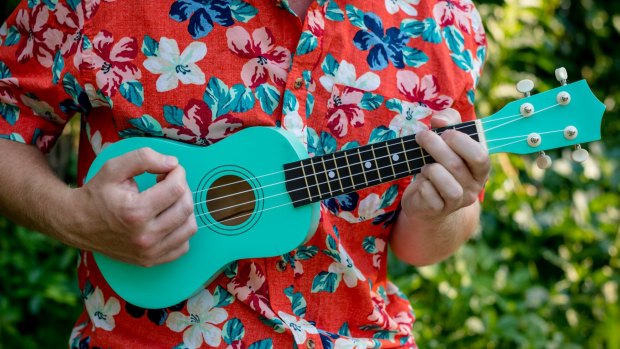This was published 4 years ago
The intriguing truth behind Hawaiian shirts: Where their iconic shirt is actually from
By Katrina Lobley

The perfect Hawaiian shirt might just be found in Kyoto.Credit: iStock
The last thing I expect to see in Gion, one of Kyoto's geisha districts, is a touch of Hawaii. But as visitors stream past me dressed in kimonos, ready to strike a pose on the photogenic Gion Tatsumi stone bridge, a store in the narrow lane catches my eye.
A sign outside Pagong explains that the company, founded in 1919, uses a traditional technique – Kyo-yuzen – to hand-dye fabrics. Dye is painted straight onto cloth to produce vivid colours, precise lines and subtle tonal gradations. The name honours the 17th-century Edo-period artisan Miyazaki Yuzensai who originally painted fans. Patrons pressed him to apply his skills to a larger canvas –kimono fabric - and his name became synonymous with Kyoto's best kimono fabric designs.
Pagong stopped making kimono fabric in 2002, instead transforming its catalogue of patterns – think classic Japanese motifs such as carp, cherry blossoms, chrysanthemums, dragonflies and a woodblock-style giant wave - into aloha shirts. I've flown into Japan from Hawaii so the connection intrigues me. An assistant tells me aloha shirts began when tailors in Hawaii started making shirts from kimono fabric.
Well, blow me down. Former Washington State University professor, Linda Arthur Bradley, has written extensively about the multi-ethnic beginnings of the shirt she calls Hawaii's three-dimensional postcard. One story, she says, is that a group of private schoolboys on Oahu wanted matching shirts; Chinese tailors made them garments from printed Japanese crepe intended for girls' kimonos.
Dale Hope, author of The Aloha Shirt: Spirit of the Islands, recounts a similar story about a university student who had his mother's dressmaker sew him shirts from cotton yukata cloth, creating a "pre-aloha" shirt in the early 1920s. Certainly, only the rich could afford leisurewear at this time when Hawaii was still very much a plantation-based economy.
Koichiro Miyamoto, a Honolulu tailor known as Musa-Shiya the Shirtmaker, ran the first newspaper ad for aloha shirts in 1935 although Ellery Chun is credited with popularising them. In 1933, Chun had tailors turning fabrics from Japan, Tahiti and the US mainland into ready-to-wear shirts he displayed in his father's Chinese dry-goods store, King-Smith Clothiers. Chun trademarked the term in 1936.
Tourists, who had started flocking to Hawaii on cruise ships in the 1920s, and military personnel were early adopters of the shirts that had morphed into showcasing tropical motifs such as palm trees, pineapples, hibiscus flowers and surfboards. When World War II cut off textile imports to Hawaii, islanders finally adopted the kitschy shirts. The 1947 introduction of Aloha Week paved the way for aloha shirts to be worn as business attire in Hawaii.
Alfred Shaheen – an aeronautical engineer who transformed Hawaii's fledgling garment industry into a multi-million-dollar enterprise - elevated the souvenir shirt to collectable status, Bradley says. Shaheen set up a studio of textile designers led by Japanese-American designer Bob Sato. The team travelled throughout the Asia-Pacific region to collect culturally significant designs that made their fabrics works of art.
Those looking for aloha shirts in Hawaii today are spoilt for choice. With more than 15,000 vintage, new and used examples, Honolulu store Bailey's Antiques and Aloha Shirts claims to have the world's largest selection. For a muted take on the shirt, try Reyn Spooner stores on Oahu, Kauai and the Big Island. Founder Reyn McCullough was among those who lobbied politicians to introduce Aloha Friday in Hawaii in 1966 ("casual Friday" is now commonplace in offices around the globe).
But if you want to hark back to the aloha shirt's intriguing origins, pop into one of Pagong's three Kyoto stores for a hand-dyed silk number boasting coconut-shell buttons. You'll be joining fellow customer, Yoko Ono, in the fusion fashion stakes.
TRIP NOTES
MORE
SHOP
Pagong has three stores in Kyoto; the Gion outlet is located along a narrow lane of traditional shopfronts leading to the popular Gion Tatsumi Bridge. Bailey's Antiques and Aloha Shirts is at 517 Kapahulu Avenue, Honolulu. Reyn Spooner, which sells modern aloha shirts featuring everything from Volcanoes National Park to the Year of the Rat, has stores on Oahu, Kauai and the Big Island of Hawaii. See pagong.jp, alohashirts.com, reynspooner.com
FLY
Hawaiian Airlines flies between Sydney and Brisbane to Honolulu, Oahu, with regular connections to other major Hawaiian islands. It also flies between Honolulu and Osaka (Kansai), 15 minutes by bullet train from Kyoto, Japan. See hawaiianairlines.com.au
Katrina Lobley was a guest of Hawaii Tourism Oceania, Hawaiian Airlines and InsideJapan Tours.
Sign up for the Traveller Deals newsletter
Get exclusive travel deals delivered straight to your inbox. Sign up now.